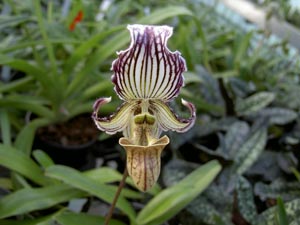"Karelia", ¹32, April 30th, 2013
 Year 2013 – the Environment Year
Year 2013 – the Environment Year One of the key events in the republic linked to the National Environment Year will be the Roundtable “Red Data Book of the Republic of Karelia” organized by the RK Ministry of Nature Use and Environment. A forerunner of the Roundtable scheduled for early June was the meeting of the regional unit of the Russian Botanical Society. The members of the Society – scientists, researchers from the Karelian Research Centre, Russian Academy of Sciences (KarRC of RAS), discussed the current situation with red-listed botanical species, made suggestions on modifying the status of some of them.
The Red Data Book of the Republic of Karelia has been through two editions already (the second one published in 2007). The flora is widely represented in the book – hundreds of species of vascular plants, mosses, lichens and fungi.
In 2012, specialists from the KarRC of RAS Forest Research Institute and Institute of Biology were contracted by the Ministry of Nature Use and Environment to carry out an assessment of the current situation with red-listed species. Red Data Books published by the neighbours (Vologda, Arkhangelsk, Murmansk Regions, Komi Republic, Finland, and Sweden) helped specify the status of some species. As the result, new candidates for red-listing were identified. New nominations for the list of rare and endangered plants include one vascular plant species (meadow fescue), eight species of fungi, more than a dozen moss and lichen species.
Quite a few of the rarest species are mosses. The last time one of them, called the Hutchinson’s ulota and growing on rocks, was found in Karelia was in 1905. Another one, Encalypta spathulata, which is regarded critically endangered, has not been encountered here since 1936. Nonetheless, the editor of the botany section of the Red Data Book of Karelia Dr. Oleg Kuznetsov (Head of the Mire Ecosystems Laboratory at the Institute of Biology, KarRC of RAS) says their isn’t much reason to be concerned about the situation with red-listed botanical species in Karelia in general. Only a few representatives of the plant community are now under threat. As a rule, these are the species home to which is old-growth forest or rock outcrops, which get overgrown in a natural way or are destroyed by mining.
– Quite a number of moss and lichen species in Karelia occur only in the Paanajärvi National Park and Priladozhje, – says Oleg Kuznetsov. – If we exploit Priladozhje carelessly there’s a risk we may lose many extremely rare species. The future Ladoga Skerries National Park may easily turn out to be the richest in red-listed species among its peers. That is why we’re struggling so hard to have it founded as soon as possible.
A speaking fact is the difference in the distribution of certain red-listed species on the two sides of the national border. Oleg Kuznetsov explained that “proper” forestry practices, where a tree doesn’t stay in the site to decay naturally, cause many wood-decay species to become rare. Availability of rotting timber at various stages of decay makes them unique. It has now become common practice for Europeans to come here to watch the natural processes of wood decomposition, in which fungi and some moss species are active agents.
Speaking of some meadow- and floodplain-dwelling herbaceous plants. Most ordinary meadows in European countries have been made arable (ploughed and fertilized), and floodplain meadows – drained. As a result, many shore and meadow plants, failing to adapt to the new conditions, have gone extinct or rare. In Finland, for instance, one can now hardly find the once common maiden pink, whereas we can still enjoy a glade covered in tender little flowers of this plant.
My next question to Oleg Kuznetsov is about the “May greetings” – lily-of-the-valley. Some people think the flower is red-listed and dare not pick a single plant, whereas others pick whole white bouquets both for fun and for sale without any scruples.
The scientist comments that lily-of-the-valley was mentioned in a 1985 popular science edition as a decorative plant that blossoms beautifully, and hence requires protection. On the other hand, the lily-of-the-valley population remains viable, and is not likely to vanish if flowers are gathered without damaging the roots. The same is true for the marsh cinquefoil (purple marshlocks) – another actively harvested regionally wide-spread plant. The marsh cinquefoil would regenerate well if harvesting is limited to the aboveground parts, which are quite rich in curative substances, and the rootstock is left intact.
Far more vulnerable is the roseroot, or golden root, with its narrow distribution range, confined to cliffy parts of the White Sea coast. In the roseroot, medicinal qualities are contained in the aboveground parts, and the population of this rare species can be easily undermined by tearing whole plants out. Luckily, people learnt to grow the roseroot in private land plots, and the species has a chance to retain its position in the natural habitat.
The new edition of the Red Data Book will be prepared taking into account both expertise from neighbour regions, and new data on the distribution of rare species gathered by botanists in Karelia.
Sergey Khokhlov



